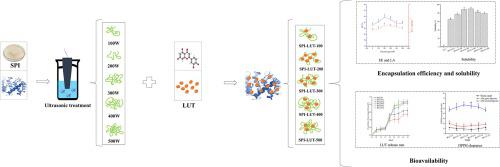Ultrasonics Sonochemistry ( IF 8.7 ) Pub Date : 2022-06-22 , DOI: 10.1016/j.ultsonch.2022.106075 Fuwei Sun 1 , Bailiang Li 1 , Yanan Guo 1 , Yichang Wang 1 , Tianfu Cheng 1 , Qingyu Yang 2 , Jun Liu 3 , Zhijun Fan 4 , Zengwang Guo 1 , Zhongjiang Wang 1

|
The combination of protein and flavonoids can ameliorate the problems of poor solubility and stability of flavonoids in utilization. In this study, soybean protein isolate pretreated by ultrasonication was selected as the embedding wall material, which was combined with luteolin to form a soybean protein isolate-luteolin nanodelivery system. The complexation effect and structural changes of soybean protein isolate (SPI) and ultrasonic pretreatment (100 W, 200 W, 300 W, 400 W and 500 W) of soybean protein isolate with luteolin (LUT) were compared, as well as the changes in digestion characteristics and antioxidant activity in vitro. The results showed that proper ultrasonic pretreatment increased the encapsulation efficacy, loading amount and solubility to 89.72%, 2.51 μg/mg and 90.56%. Appropriate ultrasonic pretreatment could make the particle size and the absolute value of ζ-potential of SPI-LUT nanodelivery system decrease and increase respectively. The FTIR and fluorescence results show that appropriate ultrasonic pretreatment could reduce α-helix, β-sheet and random coil, increase β-turn, and enhance fluorescence quenching. The thermodynamic evaluation results indicate that the ΔG < 0, ΔH > 0 and ΔS > 0, so the interaction of LUT with the protein was spontaneous and mostly governed by hydrophobic interactions. The XRD results show that the LUT was amorphous and completely wrapped by SPI. The DSC results showed that ultrasonic pretreatment could improve the thermal stability of SPI-LUT nanodelivery system to 112.66 ± 1.69 °C. Digestion and antioxidant analysis showed that appropriate ultrasonic pretreatment increased the LUT release rate and DPPH clearance rate of SPI-LUT nanodelivery system to 89.40 % and 55.63 % respectively. This study is a preliminary source for the construction of an SPI nanodelivery system with ultrasound pretreatment and the deep processing and utilization of fat-soluble active substances.
中文翻译:

超声波预处理大豆分离蛋白对蛋白质-木犀草素纳米递送系统结合效率、结构变化和生物利用度的影响
蛋白质与黄酮类化合物的结合可以改善黄酮类化合物在利用中溶解性差和稳定性差的问题。本研究选用超声预处理的大豆分离蛋白作为包埋壁材料,与木犀草素结合形成大豆分离蛋白-木犀草素纳米递送体系。比较大豆分离蛋白(SPI)和超声波预处理(100 W、200 W、300 W、400 W和500 W)大豆分离蛋白与木犀草素(LUT)的络合效果和结构变化,以及在体外消化特性和抗氧化活性。结果表明,适当的超声预处理使包封率、负载量和溶解度分别提高到89.72%、2.51 μg/mg和90.56%。适当的超声预处理可以使SPI-LUT纳米传递体系的粒径和ζ电位绝对值分别减小和增大。FTIR和荧光结果表明,适当的超声预处理可以减少α-螺旋、β-折叠和无规卷曲,增加β-转角,增强荧光猝灭。热力学评价结果表明,ΔG < 0、ΔH > 0和ΔS > 0,因此LUT与蛋白质的相互作用是自发的,主要受疏水相互作用的支配。XRD结果表明LUT是无定形的并且完全被SPI包裹。DSC结果表明,超声预处理可以将SPI-LUT纳米递送系统的热稳定性提高到112.66±1.69℃。消化和抗氧化分析表明,适当的超声预处理使SPI-LUT纳米递送系统的LUT释放率和DPPH清除率分别提高到89.40%和55.63%。本研究为构建超声预处理SPI纳米递送系统及脂溶性活性物质深加工利用提供了初步资源。











































 京公网安备 11010802027423号
京公网安备 11010802027423号